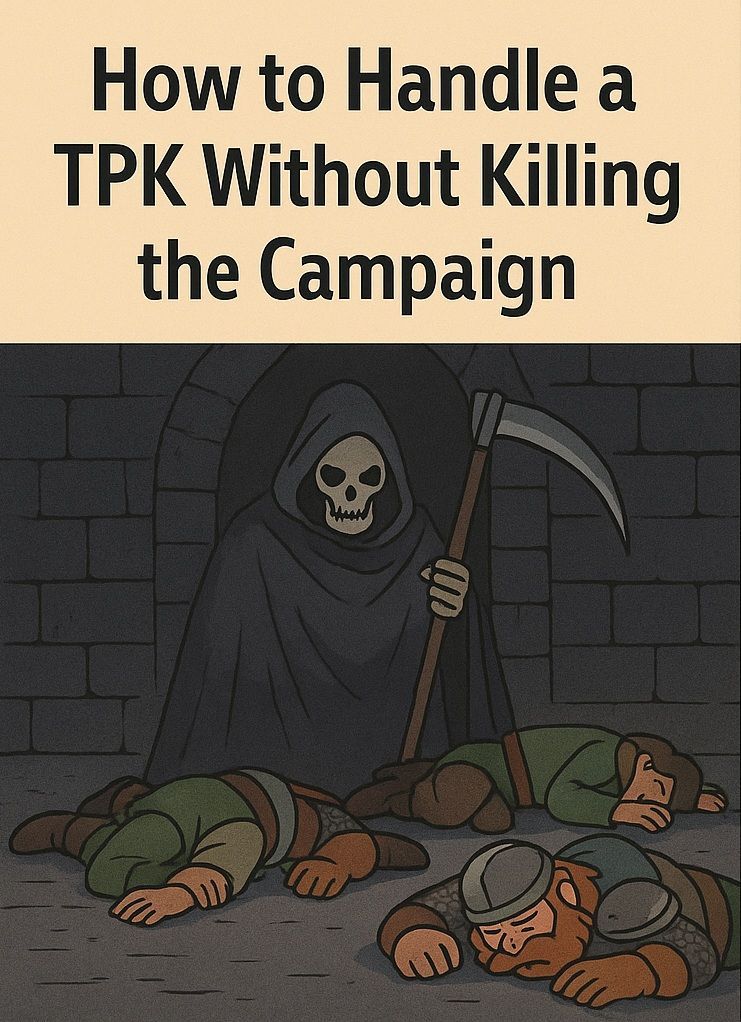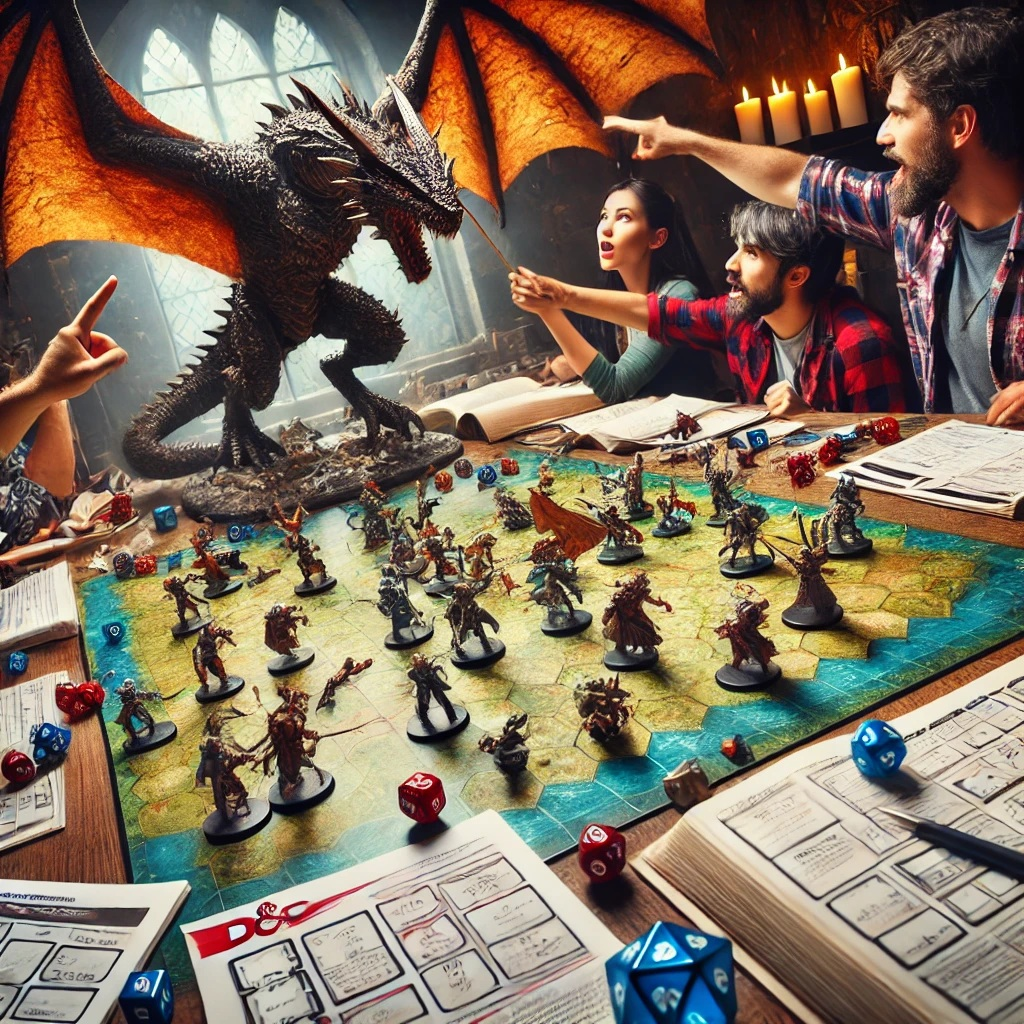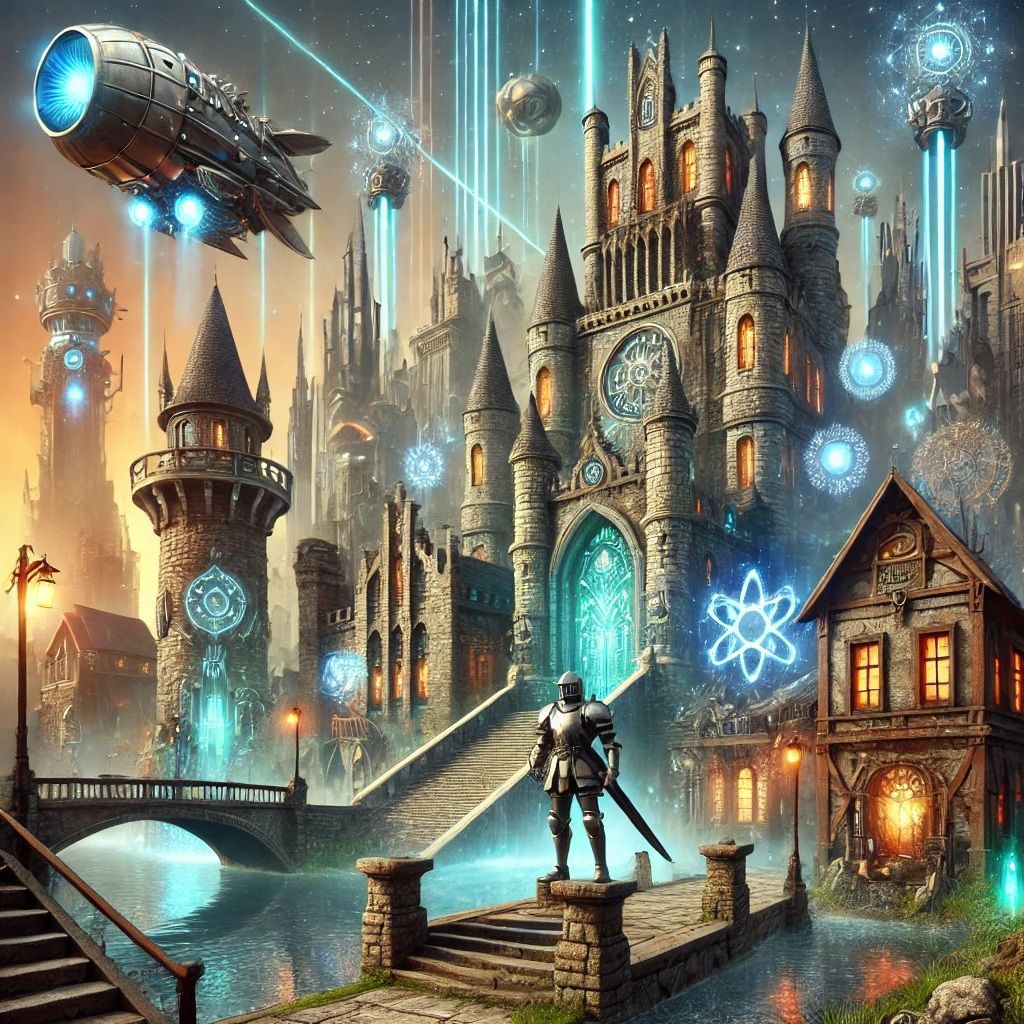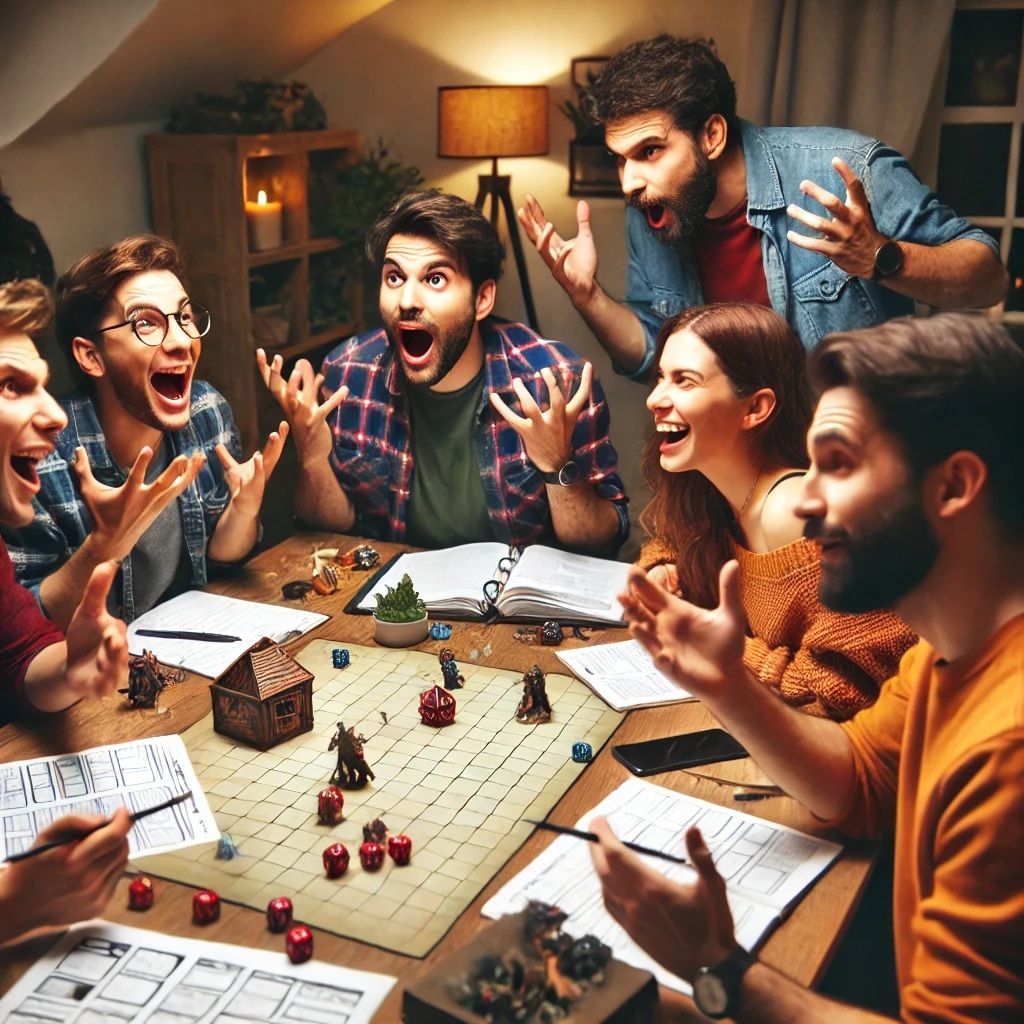DM Burnout: Recognizing and Overcoming Dungeon Master Fatigue

Dear Readers, welcome back to our Dungeons & Dragons (D&D) blog! We’ve touched on this subject before, but I wanted a more updated and comprehensive look at this topic. Today, we tackle a topic that many Dungeon Masters (DMs) face but often hesitate to discuss: burnout. Being a DM is a rewarding and creative endeavor, but it can also be incredibly demanding. The pressures of preparation, storytelling, and managing a group can lead to fatigue and burnout. Recognizing the signs and knowing how to overcome DM fatigue is crucial to maintaining a healthy and enjoyable gaming experience. In this post, we’ll explore the causes of DM burnout, identify its symptoms, and offer strategies to prevent and recover from it. So, let’s embark on this journey to ensure that your passion for DMing remains vibrant and sustainable.
Understanding DM Burnout
DM burnout is a state of physical, mental, and emotional exhaustion resulting from the demands of running a D&D campaign. It can manifest in various ways, from a lack of motivation and creativity to feeling overwhelmed and stressed. Understanding the underlying causes is the first step in addressing and overcoming burnout.
Common Causes of DM Burnout:
1. Over-Preparation:
- Spending excessive time preparing for sessions can lead to exhaustion. DMs often feel the need to have every detail planned out, which can be overwhelming.
2. High Expectations:
- Setting unrealistic expectations for yourself or feeling pressured to meet players’ high expectations can contribute to burnout.
3. Lack of Player Engagement:
- When players are disengaged or unappreciative, it can sap the DM’s enthusiasm and energy.
4. Creative Fatigue:
- Continuously coming up with new ideas, storylines, and encounters can drain your creative resources.
5. Balancing Life and DMing:
- Juggling DM responsibilities with work, family, and other commitments can lead to burnout if not managed properly.
Recognizing the Symptoms of DM Burnout
Recognizing the symptoms of DM burnout is crucial for addressing it early. Here are some common signs to look out for:
Emotional Symptoms:
1. Lack of Motivation:
- Feeling unmotivated to prepare for sessions or run the game.
2. Irritability:
- Becoming easily irritated or frustrated with players or the game itself.
3. Apathy:
- Losing interest in the game and feeling indifferent about its outcomes.
Physical Symptoms:
1. Fatigue:
- Feeling physically exhausted, even after resting.
2. Headaches:
- Experiencing frequent headaches, possibly due to stress.
3. Sleep Issues:
- Having trouble sleeping or experiencing disrupted sleep patterns.
Cognitive Symptoms:
1. Creative Block:
- Struggling to come up with new ideas or feeling mentally drained.
2. Difficulty Concentrating:
- Finding it hard to focus during preparation or sessions.
3. Memory Problems:
- Forgetting important details about the campaign or characters.
Strategies to Prevent DM Burnout
Preventing DM burnout requires proactive strategies to manage the demands of DMing and maintain a healthy balance. Here are some tips to help you avoid burnout:
1. Set Realistic Expectations
For Yourself:
- Recognize that you don’t need to be perfect. Allow yourself to make mistakes and learn from them.
For Your Players:
- Communicate openly with your players about what you can realistically manage. Setting clear expectations can help alleviate pressure.
2. Simplify Your Prep Work
Use Pre-Made Resources:
- Utilize pre-made adventures, maps, and NPCs to reduce preparation time.
Focus on Key Elements:
- Concentrate on the most important aspects of the session, such as key encounters and story beats, rather than detailing every possible scenario.
Delegate to Players:
- Encourage players to contribute to world-building or manage certain aspects of the game, such as tracking initiative or managing inventories.
3. Create a Supportive Player Environment
Encourage Player Engagement:
- Foster an environment where players are actively involved and invested in the story. This can reduce the burden on you as the DM.
Communicate Openly:
- Keep an open line of communication with your players. Discuss any concerns or challenges you’re facing and seek their support and understanding.
Set Boundaries:
- Establish boundaries to ensure that DMing doesn’t take over your personal life. Set aside specific times for preparation and gaming, and stick to them.
4. Take Breaks and Self-Care
Schedule Breaks:
- Regularly schedule breaks between sessions to recharge. This can be a short hiatus or a longer break if needed.
Prioritize Self-Care:
- Take care of your physical and mental health. Exercise, get enough sleep, and engage in activities that bring you joy outside of D&D.
Practice Mindfulness:
- Incorporate mindfulness practices, such as meditation or deep breathing, to manage stress and maintain focus.
Recovering from DM Burnout
If you’re already experiencing DM burnout, it’s important to take steps to recover and rekindle your passion for the game. Here are some strategies to help you bounce back:
1. Take a Break
Short-Term Break:
- Take a short break from DMing to rest and recover. Use this time to focus on other hobbies and interests.
Long-Term Hiatus:
- If needed, take a longer hiatus from DMing. Inform your players and use this time to recharge fully.
2. Seek Inspiration
Consume Media:
- Read books, watch movies, and play games that inspire you. Drawing inspiration from different sources can reignite your creativity.
Engage with the Community:
- Connect with other DMs and players through online forums, social media, or local gaming groups. Sharing experiences and ideas can provide fresh perspectives.
Explore New Genres:
- Experiment with new genres or settings in your campaign. A change of pace can reinvigorate your interest and creativity.
3. Re-Evaluate Your Approach
Assess Your Style:
- Reflect on your DMing style and identify what’s working and what’s not. Consider making adjustments to your approach.
Simplify Your Game:
- Simplify your campaign to reduce complexity and focus on the core elements that bring you and your players the most joy.
Incorporate Player Feedback:
- Seek feedback from your players on what they enjoy most about the game. Use this feedback to tailor the campaign to everyone’s preferences.
4. Share the Load
Co-DM:
- Consider co-DMing with another player. Sharing the responsibilities can lighten the load and provide a fresh perspective.
Rotate DMs:
- Rotate the DM role among your group. This gives you a break and allows other players to experience DMing.
Delegate Tasks:
- Delegate specific tasks to players, such as managing NPCs, tracking initiative, or handling in-game logistics.
Tips for Maintaining Long-Term DM Health
Maintaining long-term DM health involves establishing sustainable practices and habits that prevent burnout and promote enjoyment. Here are some tips for long-term success:
1. Balance Gaming and Life
Time Management:
- Manage your time effectively to balance gaming with work, family, and other commitments.
Set Priorities:
- Prioritize your health and well-being. Remember that it’s okay to put your needs first.
Maintain Boundaries:
- Maintain clear boundaries between your gaming life and personal life to prevent burnout.
2. Foster a Positive Gaming Environment
Build a Supportive Group:
- Cultivate a gaming group that is supportive, respectful, and understanding.
Encourage Fun and Creativity:
- Focus on creating a fun and creative environment where everyone can enjoy the game.
Celebrate Successes:
- Celebrate the successes and milestones of your campaign, both big and small.
3. Continuously Learn and Grow
Expand Your Skills:
- Continuously develop your DMing skills by learning new techniques and approaches.
Stay Updated:
- Stay updated with the latest D&D resources, rules, and community trends.
Embrace Change:
- Be open to change and willing to adapt your style and approach as needed.
Case Studies: Overcoming DM Burnout
Let’s explore a few case studies to illustrate how different DMs have recognized and overcome burnout.
Case Study 1: Sarah’s Over-Preparation
Background:
- Sarah is a meticulous DM who spends hours preparing for each session. She creates detailed maps, elaborate NPC backgrounds, and intricate plotlines.
Problem:
- Sarah’s over-preparation leads to burnout, as she feels exhausted and overwhelmed before each session.
Solution:
- Sarah decides to simplify her prep work by using pre-made resources and focusing on key story elements. She sets realistic goals for each session and delegates some tasks to her players.
Outcome:
- With reduced preparation time, Sarah feels more energized and enjoys DMing again. Her players appreciate the streamlined sessions and are more engaged in the story.
Case Study 2: Tom’s Creative Fatigue
Background:
- Tom has been running a long-term campaign for over a year. He prides himself on creating unique and engaging storylines.
Problem:
- Tom experiences creative fatigue, struggling to come up with new ideas and feeling uninspired.
Solution:
- Tom takes a short break from DMing to recharge. During this time, he consumes media that inspires him and engages with the D&D community for fresh ideas.
Outcome:
- After the break, Tom returns with renewed creativity and enthusiasm. He introduces new genres and elements to his campaign, which reinvigorates both him and his players.
Case Study 3: Alex’s Player Disengagement
Background:
- Alex runs a campaign with a group of friends. Recently, he’s noticed that some players seem disengaged and uninterested.
Problem:
- The lack of player engagement makes Alex feel unappreciated and frustrated, leading to burnout.
Solution:
- Alex holds a session zero to discuss the campaign and gather player feedback. He encourages players to share what they enjoy and what they’d like to see more of in the game.
Outcome:
- With input from his players, Alex adjusts the campaign to better align with their interests. Player engagement improves, and Alex feels more supported and motivated.
Additional Strategies for Overcoming DM Burnout
In addition to the strategies mentioned earlier, here are some additional tips and techniques to help overcome and prevent DM burnout.
1. Embrace Improvisation
Reduce Prep Time:
- Embrace improvisation to reduce the time spent on preparation. Trust your ability to create engaging content on the fly.
Example:
- Instead of planning every detail, prepare a few key plot points and let the players’ actions guide the story. This approach keeps the game dynamic and lessens your workload.
Improvisation Techniques:
- Use random tables for encounters and events.
- Keep a list of generic NPC names and traits handy.
- Practice thinking on your feet and adapting to unexpected player choices.
2. Rotate Campaigns and Settings
Variety and Freshness:
- Rotate between different campaigns and settings to keep things fresh. This prevents monotony and keeps your creativity flowing.
Example:
- Alternate between a high-fantasy campaign, a sci-fi adventure, and a horror-themed storyline. Each setting offers new challenges and opportunities for creativity.
Benefits:
- Provides a change of pace and prevents burnout.
- Allows you to explore different genres and themes.
- Keeps players engaged with diverse experiences.
3. Collaborate with Players
Co-Creation:
- Collaborate with your players to create the world and story. This shared responsibility can lighten your load and make the game more engaging.
Example:
- Encourage players to contribute to world-building by creating factions, cities, or backstory elements. This collaborative approach fosters investment and reduces your workload.
Collaborative Techniques:
- Hold world-building sessions where players contribute ideas.
- Use player backstories to generate plot hooks and side quests.
- Encourage players to run one-shot adventures within the campaign.
4. Use Technology and Tools
Efficiency:
- Utilize technology and tools to streamline your DMing process. Digital tools can help with preparation, organization, and gameplay management.
Example:
- Use virtual tabletops (VTTs) like Roll20 or Fantasy Grounds to manage maps and combat. Tools like D&D Beyond can help with character management and rule references.
Recommended Tools:
- Roll20: For online maps, tokens, and dynamic lighting.
- Fantasy Grounds: For automated combat and character sheets.
- D&D Beyond: For rulebooks, character management, and encounter builders.
- World Anvil: For campaign management and world-building.
Supporting Fellow DMs
Supporting fellow DMs is crucial for building a strong and resilient D&D community. Here are some ways to offer support and encouragement to other DMs who may be experiencing burnout.
1. Share Resources and Tips
Resource Sharing:
- Share resources, tips, and tools that have helped you manage DMing more effectively.
Example:
- Create a shared folder with pre-made maps, NPCs, and encounters that other DMs can use.
Community Support:
- Participate in online forums, social media groups, and local gaming communities to share advice and support fellow DMs.
2. Offer to Co-DM or Run One-Shots
Co-DMing:
- Offer to co-DM or run one-shot adventures for fellow DMs who need a break.
Example:
- Organize a rotation where each DM takes turns running a session, allowing others to rest and recharge.
Benefits:
- Provides relief and support for DMs experiencing burnout.
- Offers fresh perspectives and ideas for the campaign.
- Fosters a sense of community and collaboration.
3. Provide Encouragement and Validation
Encouragement:
- Offer words of encouragement and validation to fellow DMs. Acknowledge their hard work and dedication.
Example:
- Send a message of appreciation or publicly recognize their efforts in a gaming group or forum.
Building Confidence:
- Help build their confidence by sharing positive feedback and celebrating their successes.
Case Study 4: Emily’s Balancing Act
Background:
- Emily is a dedicated DM who loves crafting intricate storylines and immersive worlds. However, she also has a demanding job and family commitments.
Problem:
- Balancing DMing with her other responsibilities leads to burnout, as she struggles to find time for preparation and running sessions.
Solution:
- Emily adopts a more flexible approach to DMing. She simplifies her prep work by using pre-made adventures and online tools. She also sets a regular schedule that accommodates her personal commitments.
Outcome:
- With a more manageable schedule and streamlined prep process, Emily finds it easier to balance her responsibilities. She enjoys DMing without feeling overwhelmed.
Building a Sustainable DM Routine
Establishing a sustainable DM routine is key to preventing burnout and maintaining long-term enjoyment. Here are some steps to build a routine that works for you:
1. Establish a Schedule
Regular Sessions:
- Set a regular schedule for game sessions that works for both you and your players. Consistency helps manage expectations and reduces stress.
Example:
- Schedule bi-weekly sessions on Saturday evenings, ensuring everyone has ample time to prepare and participate.
Preparation Time:
- Allocate specific times for preparation and stick to them. Avoid last-minute prep to reduce stress.
2. Set Achievable Goals
Session Goals:
- Set achievable goals for each session. Focus on key story beats and encounters rather than overwhelming yourself with details.
Example:
- Plan for three major encounters or plot points per session, allowing flexibility for player actions.
Campaign Goals:
- Establish long-term goals for your campaign, but be flexible and willing to adapt as the story progresses.
3. Prioritize Self-Care
Physical Health:
- Prioritize your physical health by getting regular exercise, eating well, and getting enough sleep.
Mental Health:
- Practice mindfulness, meditation, or other stress-relief techniques to maintain mental well-being.
Personal Time:
- Set aside time for hobbies and activities outside of D&D to recharge and maintain a balanced life.
4. Continuously Reflect and Adjust
Regular Check-Ins:
- Regularly check in with yourself and your players to assess how things are going. Make adjustments as needed to ensure everyone is enjoying the game.
Feedback Loop:
- Encourage players to provide feedback on the campaign and your DMing style. Use this feedback to make improvements and address any concerns.
Example:
- Hold a quarterly meeting with your players to discuss what’s working and what could be improved. Use this feedback to adjust your approach and enhance the game.
Conclusion
DM burnout is a common challenge, but it’s one that can be overcome with awareness, proactive strategies, and support. By recognizing the signs of burnout, implementing sustainable practices, and fostering a supportive community, you can maintain your passion for DMing and continue to create memorable and enjoyable experiences for your players.
Remember, being a Dungeon Master is a marathon, not a sprint. Take care of yourself, set realistic expectations, and don’t be afraid to ask for help when needed. With the right approach, you can enjoy a fulfilling and sustainable DMing journey.
Until next time, Dear Readers…
























